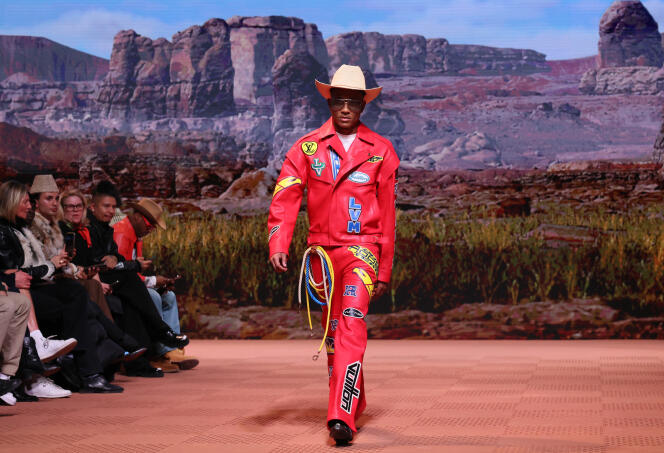


In today's tense geopolitical context and against the backdrop of climate change, what can a fashion designer say during the routinely scheduled fashion week, as predictable as a Swiss cuckoo clock? During this Fall-Winter 2024-2025 season, presented in Paris from January 16 to 21, the designers' intentions converged in one direction: to reveal their identity through clothes, transforming the catwalk exercise into a story of origins, most of the time with a political subtext.
At Louis Vuitton, the Pharrell Williams show transformed into a grand event. Hosted at the Fondation Vuitton in the Bois de Boulogne, 1,400 people gathered under the neon lights for the presentation of "Paris Virginia" – a nod to the designer's home state. Under a huge tent, giant screen walls depicted an arid Wild West landscape, where the sun gradually gave way to a snowstorm. It was the perfect cinematic backdrop for Pharrell's dressed-up cowboys, as he fashioned the wardrobe of the American West with hats, cowboy boots, plaid shirts, overtrousers and thick-buckled belts.
Presented in this way, the project looked like a caricature. On the one hand, the collection was clever, mixing Far West and workwear vocabulary (multi-pocket pants or jackets, in collaboration with Timberland), amusing details (a cactus print) and serious craftsmanship (scalloped leather bags). On the other hand, Pharrell casually slipped in a political message: "When you see cowboys portrayed you see only a few versions. You never really get to see what some of the original cowboys looked like. They looked like us. They looked like me. They were black and they were Native American," he explained backstage after the show. The models chosen for the show embodied this diversity. In addition, artists from the Dakota and Lakota Native American tribes contributed to the soundtrack, as well as to the design of hand-painted and embroidered bags. Pop star Pharrell wasn't revolutionizing fashion, but he managed to meet the "Vuittonesque" mandate that every fashion show should be a journey and to color it with discreet activism.
Grace Wales Bonner, meanwhile, has continued to explore Black culture and identity through successive collections. This season, the Jamaican-born Brit turned her attention to Howard University in Washington, DC, historically the first college to educate Black Americans. The designer, who sees her work as that of a researcher, immersed herself in the documents of the university's research center on the history of Black populations. The result was a wardrobe imbued with academic codes like checked jackets, slim-fitting blazers and duffle coats. It also embraced athletic influences, as the university is renowned for its sports teams: baseball jackets printed with her initials, sweatshirts with "Howard" inscribed on them or pieces from her collaboration with Adidas, including new Superstar Originals sneakers in embossed leather. 1990s American cult rapper Yasiin Bey (Mos Def) accompanied the show with his legendary flow. A delightful scene.
At Botter, Rushemy Botter and Lisi Herrebrugh blended references to their Caribbean heritage with environmental discourse: "Fashion is a place for dreaming, but this is not the time for fantasy, you have to have your feet on the ground," they said. Colorful fabric patchworks accentuated the silhouettes, with pants ingeniously repurposed as jackets. The formal essence of a shirt and necktie was softened by layering with windbreakers or jerseys, reflecting the football culture of Curaçao. On a hooded sweater, the logo of the Shell Oil Company was hijacked into "Hell." "We're not afraid to say what we think," summed up the duo, who have created their most desirable and accomplished collection to date.
Burc Akyol grew up in Dreux, a town in northern France that he said has a "bad reputation." "It was there that the first far-right mayor was elected in the 1980s, largely due to the significant presence of immigrants, including my family," explained this man in his thirties of Turkish origin. The feeling of not being completely accepted has shaped his sensibility. This is what he expressed in his "Made in Dreux" collection, in which men wore pants that floated around their legs, transparent fishnet tops, black wool suits or tuxedos adorned with an asymmetrical fuchsia cape. All these elements echoed the minimalism of the concrete building he grew up in, the shimmering colors of the Lacroix or Saint-Laurent shows he admired and a taste for fine fabrics inherited from his father, who was a tailor. It was a skillfully crafted return to his roots.
Translation of an original article published in French on lemonde.fr; the publisher may only be liable for the French version.
